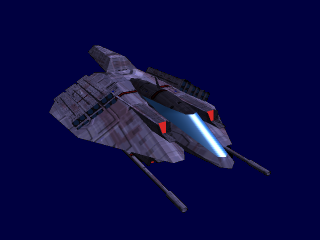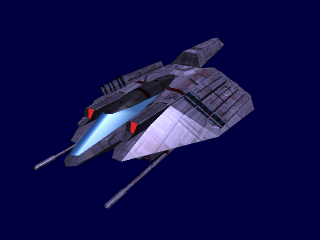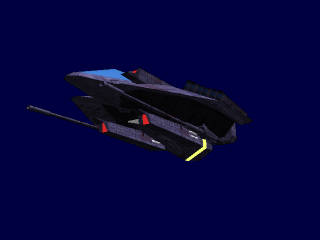Table of Contents
Wayfarer-Class Shuttle
The Wayfarer-Class shuttle was designed by Kakutama Heavy Industries in YE 30.
About the Ship
The Wayfarer-Class Shuttle is designed to fill the role of a combat shuttle craft for use within the United Outer Colonies. It shares some characteristics from its civilian brother the Journey-Class Shuttle in overall frame, and hull design with some marked improvements and upgrades to some of its systems including on board weapon systems. While it can fill a fighter craft role to a degree, it can also fill others as well from recon, tactical troop deployment and fire support meaning it can be used as a singular role craft as well as fill multiple roles upon a given situation.
History and Background
The Wayfarer concept was conceived several weeks after the Journey-Class Shuttle hit the United Manufacturing Cooperative production line. After revisiting the overall structure of the design to plan future upgrades, the designer, Tai Shichou noted the design could also fill another role if properly outfitted. Being that the frame's construction followed the same techniques used with the Harbinger-Series Drop Pod made the frame quite resilient for a civilian shuttle design. Within the next several days Tai Shichou brought a new concept for the frame, hull and some of the systems to Kakutama Heavy Industries's conceptual design department. Seeing where their boss had started they filled in the blanks to turn a civilian shuttle into a combat oriented military one for use within the Colonies.
Statistics and Performance
General
Class: Kh-T2-1c Type: Multi-Role Combat Shuttle Designers: Kakutama Heavy Industries Manufacturer: Kakutama Heavy Industries, United Manufacturing Cooperative Production: Mass Production
Passengers
Crew: 2 Maximum Capacity: There are accommodations for 4 people. About 6 people can fit aboard in an emergency, but the ship would be extremely cramped.
Dimensions
Length: 16m Width: 14m Height: 3.5m Decks: 1.5
Propulsion and Range
| 2 | Combat Shuttle | .375c | 10,000c (1.14 ly/h) |
|---|
Inside the Ship
Deck Layout
- Deck One: Main Deck
- Deck One Point Five: Cargo Space, engineering panel access.
Inside the Wayfarer
Pilot Section
The Bridge of the Wayfarer is more complex then its civilian counterpart. Typically whereas The Journey could be run by one person, the Wayfarer requires two for combat based operation. In addition to the standard equipment the Journey has, extra military-grade equipment has been added to supplement the systems and also be in place as redundancies in case of equipment failure, or malfunction. There is seating for two individuals which replaces sheer comfort with functionality, and survivability. These seats also have inbuilt systems inspired by the Treatment and Examination Bed concept, and technologies. In the event of emergencies, or extreme distance travel, these seats can be folded back, and used as stasis units complete with protective dome-like coverings over the individual via a Pico-Jelly derived protective dome.
The seats also have built in volumetric displays, and interfaces making them quite capable of acting as ship controls in the event of main control failure, or as personal preference. This does not however limit it to simple piloting. They can also act as a fire control system, systems monitoring and so on.
The 'window' of the Wayfarer is now constructed of Transparent Duremium Alloy over its Transparent Durandium Alloy counterpart. Blast shields are installed in the event of emergencies, and extreme combat situations. The rear-side of the shutters facing into the shuttle are coated with an OLED material which mimics the scenery which would be seen on the other side of the shutters. Additionally, the OLED material can be utilized as a HUD.
Passenger Section
The passenger section is located behind the pilot section. The passenger section, if it can be called that, consists of four seats, with seats placed back-to-back in pairs to conserve space. The seats are capable of being folded, to allow for improved internal movement clearance. The passenger section is quite cramped, and it remains questionable if it would be able to comfortably accommodate some larger Lorath Fyunnen or ID-SOLs
Galley
Decreased in size from the Journey's kitchenette, the Wayfarer has been instead equipped with a galley of a much smaller proportion. The galley portion of the Wayfarer consists of a mini-fridge, a small organic tissue culture unit, and a 'Hot Box' Emfratec cooker. The galley is located in the passenger section.
Bathroom
The Wayfarer has had it's bathroom shrunk down from its previous toilet and shower configuration to having a squatting-type toilet sunk into the deck plate. This same toilet is also used as a shower drain. A water nozzle is located above the toilet, and a grate can be pulled over the toilet which the individual whom is showering can stand upon. The toilet/drain includes a low-power vacuum device which is utilized to pull waste water and waste down the drain in the event of a gravity failure. A hand cleanser and soap dispenser device is located beside the doorway inside this small bathroom.
Engineering Access
With the re-tooling of the interior of the Journey frame to become the Wayfarer, engineering access has been reworked. In the Wayfarer application of the design, the engineering access consists of two panels, one located to the left and one located to the right of the passenger area. These panels allow access to the antimatter generator systems, computer systems, weapon systems, and other key components. Engineering access hatches are protected by a forcefield at all times unless authorization is given by the shuttle's pilot for disengagement.
ARIA Tank Access
In the passenger area, a portion of the floor is capable of sliding away to reveal a small space which is capable of accommodating a single ARIA unit. This small space has been commented as seeming like a coffin within a shuttle.
First Aid Station
The First Aid Station is a small chamber located against the passenger compartment wall. A panel slides open to reveal the chamber. An injured patent can be placed into this chamber, where gravity is placed in a horizontal angle instead of a vertical angle, thus effectively making up and down on a horizontal plane relative to the Wayfarer's deck plates. Within the chamber wall is a Treatment and Examination Bed.
Beside the sliding panel a Lorath first aid cabinet is included.
The first aid chamber is also equipped with a cryonic stasis system and a feature which allows for the chamber to be sealed, and filled with organic pico-jelly, and various nanomachine compounds.
Ship Systems
Hull and Space Frame
Frame
The frame of the Wayfarer is primarily constructed of Duremium Alloy rods and struts. They've been interlinked, and arranged to reinforce the frame, as well as hull to allow for quality protection, from possible attack as well as re-entry to a planet for a shuttle of its size.
Hull
The Hull of the Wayfarer is also constructed of Duremium Alloy plate. Duremium Alloy was chosen for its strength, and resilience to damage, as well as its other inherent properties.
Damage Rating:7
Computers and Electronics
Computer System
ARIA S Type
The Wayfarer utilizes an ARIA Ship Control System S-Type for the majority of it's computational, networking, and user interface needs. The S-Type was chosen due to the non-sentient nature of the unit, and the ease of production in comparison to the standard ARIA unit. However, Wayfarer pilots can choose to swap out the standard issue S-Type with their own personal ARIA.
Neural Processor Pack
To supplement the functions of the Wayfarer's automated systems and computational resources, a Neural Processor Pack module is included. This processor also includes the proper software to allow for the control of the Wayfarer without an ARIA.
System Interface
Neural Interface
A Neural Interface System is utilized to conduct high-speed commands and data access with the Wayfarer's systems. The system aboard the Wayfarer has been designed to be compatible with Jiyuuan, Lorath, and ARIA bodies.
Volumetric Virtual Display
Through the use of precision holographic imaging and projected forcefields, a floating display like those found aboard typical starships can be produced. This display is capable of being interfaced with like a typical physically solid panel. With the Wayfarer, this system is capable of also producing a simulated control interface which allows the user to manipulate the interface like a piloting yoke.
Standard Interface Panels
The pilot area of the Wayfarer includes standard flat panel interfaces which serve as displays and control access. These panels utilize high resolution displays, and an easily reconfigurable interface.
Emergency Interface System
In the event of other interface systems failing, an emergency interface has been included in the Wayfarer. The emergency interface consists of a manual control stick which manually calibrates thrust application, a set of triggers which manually activates the Wayfarer's weapon systems, and a keypad which can be utilized to input navigational commands. This system is managed by an independent Structol Class B processor.
Sensors
The Wayfarer includes Common and Uncommon Lorath Sensor Packages.
Communications
The Wayfarer's communications package includes the full range of Lorath Communications Systems technology.
ECM & Stealth Systems
To increase survivability, as well as adhere to its multi-role capacity, the Wayfarer includes some capacity in regards to ECM, and Stealth based systems. While not the best in the field, they do their job.
Sitearium Coating
ECM Suite
Emergency Systems
Fire Suppression Systems
In the event of a fire within the cabin or within a system area of the Wayfarer a fire retardant system becomes active. Within the cabin a focused foam spraying system and forcefields are utilized to contain and suppress fires. Within internal systems, the Wayfarer utilizes a forcefield system to suppress the fire and deprive it of fuel.
Hull Breach Control Systems
In the event of hull breach, the Wayfarer utilizes a combined system to suppress the breach. Precision forcefields are utilized to supplement hull durability on the Wayfarer's interior and exterior. Along with the forcefields, a Pico-Jelly spray system is utilized which applies a layer of a mixed metallic, plastic, and organic pico-jelly compound to the breach, which effectively forms a temporary patch which the duremium can later seal over.
Life Support Failure Response Measures
In the event of life support failure, the Wayfarer has a number of available solutions to overcome the lack of oxygen recycling, or vacuum decompression.
Wind Powersuit Lockers
In the event of an emergency, or in a situation of potential hazard, the Wayfarer includes six 'Wind' Armor Series. These suits can be utilized for personal life support, or for increased survivability.
Pico-jelly Suit Dispenser
In each seat, an automated pico-jelly spray system is included. In the event of sudden decompression, the system activates and coats the individual sitting in the seat with a layer of plastic Pico-Jelly. Along with the coating, an oxygen recycling mask is provided in a ceiling compartment. This recycling mask is capable of providing air for up to three days.
Emergency Communication
In the event of the Wayfarer sustaining heavy damage, going off course, or pilot error, the Wayfarer includes an automated emergency beacon system and communication transmitter. This self-contained system utilizes a QNC for power, and utilizes a subspace transmission system for general signal transmission, or subspace laser transmission. This system is capable of running for up to seven days of continued operation. The unit is contained within a large suitcase-sized box beneath the co-pilot seat.
Emergency Escape Capability
In the event of catastrophic damage to the Wayfarer, the piloting section of the Wayfarer can be separated from the rest of the ship and ejected through the use of compressed gas thrusters and low-power gravity manipulation devices. The pilot module separates itself and provides its own enclosed space by utilizing a durandium shutter which seals off the pilot section. The pilot section alone can provide life support to two individuals for up to one week. The pilot section also includes a general-area cryonic stasis system which can preserve individuals for up to fifteen years.
Self Destruct Module
In the event of potential capture, the Wayfarer includes a self-destruct module. This module consists of an antimatter containment system and a series of magnetic containment tubes which run throughout the Wayfarer's interior. In the event of activation, the containment module siphons antimatter from the reactor system and circulates it through the containment tube network. When the self-destruct countdown reaches zero, the containment system is deactivated, effectively creating an evenly distributed antimatter explosion.
The self destruct module is a system which is separately controlled from the rest of the Wayfarer's systems, thus preventing external interface with the system to ensure crew safety. However, in the event of pilot termination, the system connects itself to allied networks to allow for remote detonation.
To activate the system, the pilot must give voice authorization consisting of their name, military ID code, and personalized passcode. The pilot can then provide a time duration for the countdown sequence.
Remote Control System
In the event of pilot termination or emergency, the Wayfarer can be remotely controlled by allied networking systems. All systems are fully accessible except for the self-destruct system unless the pilot is confirmed dead by internal sensor systems.
First-Aid Tools
The Wayfarer includes the following first aid tools:
- 12-Inch Automated Medical Drones x2
- Seat Contained Treatment and Examination Bed systems and functions
- Remote control capability of the ARIA unit by medical personnel
- Automated painkiller and tissue repair nanomachine injection systems in each seat
Emergency Rations
Each Wayfarer is complimented with six Lorath Standard Issue Canteen Kit, three months supply of preserved ration biscuits, and three months supply of Nutritional Supply Pack units.
Propulsion
The Wayfarer really shines when it comes to its propulsion systems. The Wayfarer has its own high powered Sublight-Drive, and Faster-Then-Light Drive systems. These systems were taken from existing concepts and designs, and altered to suit the needs of the Wayfarer to allow it to do its job admirably.
The High Performance Plasma Drive that was used within the Journey, has received an overhaul that includes better power management, and control for use by the Wayfarer. Several systems used were gleaned from the AMX-102 WINTER, and scaled to size to fit the Wayfarer.
- Ion Rings were used on the Wayfarer for the simple reason of efficiency, as well as better overall better management of the plasma drives allowing for tighter control, and maneuverability.
- Based upon the 102's own Thermic Cycler philosophy, the one utilized within the Wayfarer utilizes waste heat generated by the plasma drives to recycle this excess heat into useful energy for use. This also serves to allow rapid cooling of the engines themselves in the event of stealth operations to cut down on their thermal profile.
The same Subspace Wave Drive technology used within the Journey has been carried over into the Wayfarer design.
Shield Systems
The Wayfarer uses gravitic, EM, and plasma shielding, which has been upgraded from the shield configuration of the Journey to allow for a proper military grade level of protection.
Damage Rating: 5 Combined Shield Activation: DR 7 for twenty seconds every ten minutes.
Power Systems
Due to the greater demand of the Wayfarer's mission profiles, the shuttle has been upgraded from the Journey's power distribution system configuration, to a far more military performance driven configuration.
Anti-Matter Generators
With the re-working of the interior of the Wayfarer and the gained space which has been devoted to the newer military related hardware, space has been gained to grant the Wayfarer a twin-generator configuration in regard to it's antimatter systems. The dual reactors are utilized for powering the Wayfarer's weapons, propulsion, and shield systems.
QNC Generator System
The Wayfarer's power systems have been augmented by the addition of a QNC generator system. This system is utilized to power the Wayfarer's computer systems, communications, sensors, and other low-demand systems. However, the QNC can also provide enough power to operate the Wayfarer's propulsion systems in the event of antimatter reactor failure.
Emergency Power
In case of main power failure, the Wayfarer has a backup emergency power source; Bacterial Charge Pack technology. Along with the bacterial charge packs, a capacitor system is tied into the charge pack system to allow for the relatively low power output to be stored and accumulated to a higher quantity and quality, which is capable of operating the Wayfarer's propulsion systems for up to fifteen minutes before being drained.
Weapon Systems
True to its name, the Wayfarer is indeed a combat oriented shuttle. A select list of weapon systems has been considered, and approved for usage aboard this vessel. However, the load out is modular, meaning while it is possible for a complete load out, often times it is switched around for mission specifics for the sake of efficiency as well as being the most effective given the task at hand.
Below is the list of armaments that the UMC and KHI have approved and certified as capable of being used aboard:
Vehicle-Mounted Compressed Packet Rifles
The Wayfarer is equipped with fourCompressed Packet Rifle units. These units are mounted on the topside and underside of the Wayfarer on the left and right sides of the pilot module.
Damage Rating
Plasma: 7 Antimatter: 8
Combined Particle Cannons
The Wayfarer is equipped with two 2-inch diameter combined particle cannons with packet compression technology. These units are mounted on the belly of the Wayfarer to the left and right sides of the pilot module.
Damage Rating
Plasma: 7 Antimatter: 9
Plasma Arc Disruptor Strips
Primarally placed as a defensive measure, the Wayfarer is equipped with five plasma arc disruptor strips with compressed packet technology. These strips are located on the top left, top right, bottom left, bottom right, and nose of the Wayfarer. Unfortunately, due to the small platform, the damage rating of these strips is reduced.
Damage Rating
7
Front-Rear Facing Missile Racks
Located in the rearward section on the left and right portions of the topside of the Wayfarer are two missile rack units. These units are capable of holding twenty-four Lorath missile ordinance S-Size Missiles. twelve facing in the forward direction, twelve facing rear for each launcher.
Damage Rating
Varies depending on missile payloads.
Countermeasure Launchers
Located in the front end of the Wayfarer beneath the pilot module, and in the rear of the Wayfarer on the left and right bottom portions are countermeasure launchers which utilize Lorath missile ordinance Mi-Size Missiles with countermeasure warheads or cannister explosive warheads with chaff. Each launcher is equipped with ten mini-missiles.
Damage Rating
1
Anti-Personnel Gatling
Located on the belly of the Wayfarer is a single 7.62mm Lorath Devil's Fountain Gatling Weapon. This Gatling is mounted on a pivoting mount allowing for a 360 degree horizontal rotation, and 90 degree vertical angle adjustment.
Damage Rating
Varies depending on ammunition
Additional
This comes standard with the Wayfarer, a repair kit has been added in. This kit is rated to repair any cracks in the hull from various spaceborn objects, or minor scuffles. However, large breaches require either evacuation of the shuttle and the immediate activation of the subspace distress beacon. The repair kit comes with a 1 gallon container of Metal & Plastic Pico-Jelly and Control Device as well as duremium patches.



